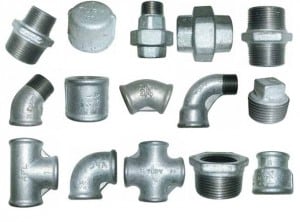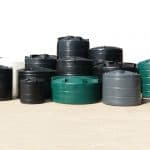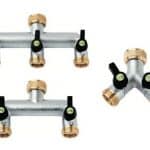Galvanised Fittings
Malleable iron is cast as White iron, the structure being a metastable carbide in a pearlitic matrix. Through an annealing heat treatment, the brittle structure as first cast, is transformed into the malleable form. Carbon agglomerates into small roughly spherical aggregates of graphite leaving a matrix of ferrite or pearlite according to the exact heat treat used. Three basic types of malleable iron are recognized within the casting industry: Blackheart malleable iron, Whiteheart malleable iron and Pearlitic malleable iron.[1]
Castability, heat treating and post-casting operations
Like other similar irons with the carbon formed into spherical or nodular shapes, malleable iron exhibits good ductility. Incorrectly considered by some to be an “old” or “dead” material, malleable iron still has a legitimate place in the design engineer’s toolbox. Malleable iron is a good choice for small castings or castings with thin cross sections (less than 0.25 inch, 6.35 mm). Other nodular irons produced with graphite in the spherical shape can be difficult to produce in these applications, due to the formation of carbides from the rapid cooling.
Malleable iron also exhibits better fracture toughness properties in low temperature environments than other nodular irons, due to its lower silicon content. The ductile to brittle transformation temperature is lower than many other ductile iron alloys.
In order to form properly the spherical-shaped nodules of graphite in the annealing process, care must be taken during the casting process to ensure the iron casting will solidify with an entirely white iron cross section. Heavier sections of a casting will cool slowly, allowing some primary graphite to form. This graphite forms random flake-like structures and will not transform in heat treatment. When stress is applied to such a casting in application, the fracture strength will be lower than normal, and the large particles of primary graphite can be seen. Such iron is said to have a ‘mottled’ appearance. Some countermeasures can be applied to enhance forming the all white structure, but malleable iron foundries often avoid producing heavy sections because of the risk of forming primary graphite through slow cooling.
After the casting and heat treatment processes, malleable iron can be shaped through cold working, such as stamping for straightening, bending or coining operations. This is possible due to malleable iron’s desirable property of being less strain rate sensitive than other materials.
What is Galvanising
Metal protection
In current use, the term refers to the coating of steel or iron with zinc. This is done to prevent rusting of the ferrous item. The value of galvanizing stems from the corrosion resistance of zinc, which, under most service conditions, is considerably greater than that of iron and steel. The zinc serves as a sacrificial anode, so that it cathodically protects exposed steel. This means that even if the coating is scratched or abraded, the exposed steel will still be protected from corrosion by the remaining zinc – an advantage absent from paint, enamel, powder coating and other methods. Galvanizing is also favored as a means of protective coating because of its low cost, ease of application and comparatively long maintenance-free service life.
The term galvanizing, while technically referring specifically to the application of zinc coating by the use of a galvanic cell (also known as electroplating), is also generally understood to include hot-dip zinc coating. The practical difference is that hot-dip galvanization produces a thick, durable and matte gray coating – electroplated coatings tend to be thin and brightly reflective. Due to its thinness, the zinc of electroplated coatings is quickly depleted, making them unsuitable for outdoor applications (except in very dry climates). When combined with subsequent painting (which slows zinc consumption), electroplating is durable enough to be used in some premium auto body coatings.
Nonetheless, electroplating is used on its own for many outdoor applications because it is cheaper than hot dip zinc coating and looks good when new. Another reason not to use hot dip zinc coating is that for bolts and nuts size M10 (US 3/8″) or smaller, the thick hot-dipped coating fills in too much of the threads, which reduces strength (because the dimension of the steel prior to coating must be reduced for the fasteners to fit together). This means that for cars, bicycles and many other ‘light’ mechanical products, the alternative to electroplating bolts and nuts is not hot dip zinc coating but making the bolts and nuts from stainless steel (known by the corrosion grades A4 and A2).
Electroplated steel is visually indistinguishable from stainless steel when new. To determine whether a part is electroplated or stainless steel, apply a magnet. The most common stainless steel alloys (including those used for bolts and nuts) are not magnetic or only very slightly attracted to a magnet.
Galvanised Fittings Applications
It is often used for small castings requiring good tensile strength and the ability to flex without breaking (ductility). Electrical fittings, hand tools, pipe fittings, washers, brackets, fence fittings, power line hardware, farm equipment, mining hardware, Irrigation and machine parts.
Advice and information always available
Check out our Galvanised Fittings in our Online Shop



